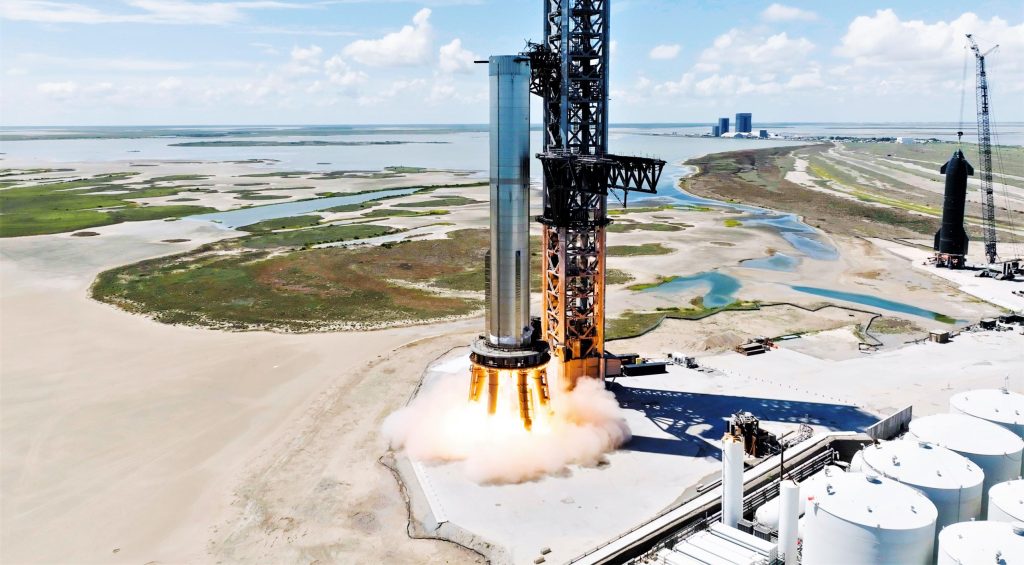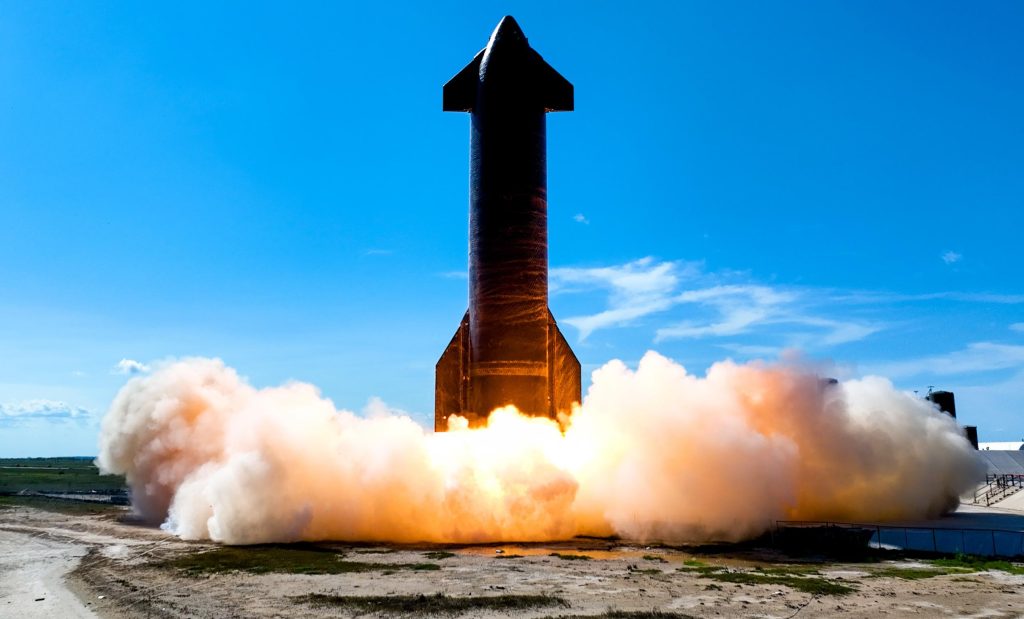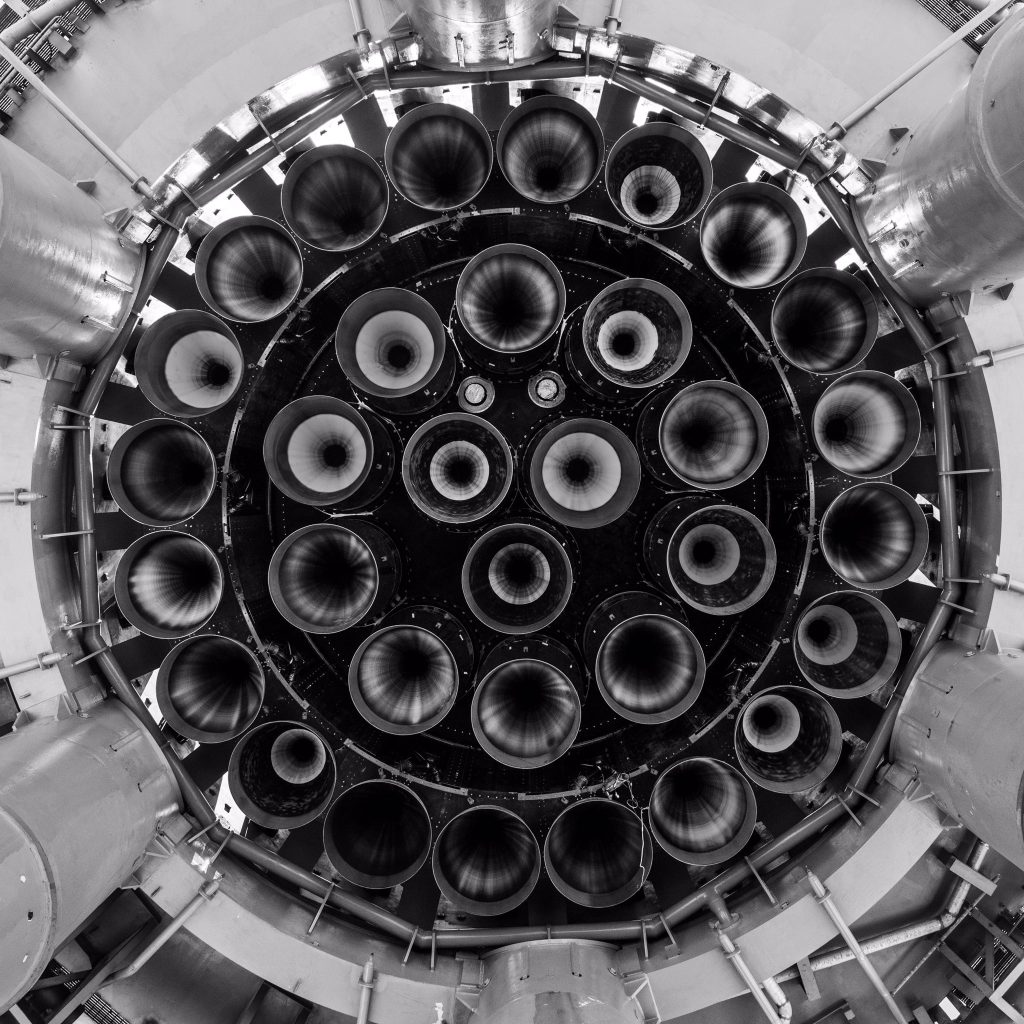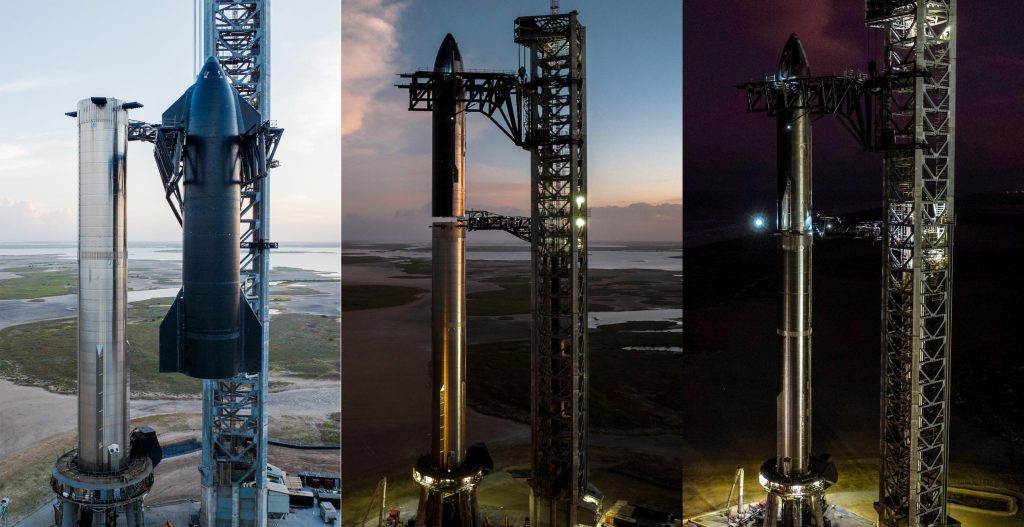23.09.2022
SpaceX Starship orbital flight 'highly likely' in November, Elon Musk says
But late October is still in play as well.

A seven-engine static fire test of SpaceX's Starship Booster 7 on Sept. 19, 2022. (Image credit: Elon Musk/SpaceX)
SpaceX's huge Starship Mars rocket could go orbital as soon as next month.
SpaceX is gearing up for the first-ever orbital test flight of Starship, the giant vehicle it's building to take cargo and people to the moon, Mars and other distant destinations. And that landmark try may be just around the corner.
"Late next month maybe, but November seems highly likely. We will have two boosters & ships ready for orbital flight by then, with full stack production at roughly one every two months," company founder and CEO Elon Musk said via Twitter today(opens in new tab) (Sept. 21), in response to a follower who asked about the timing of the test flight.
Starship consists of a huge first-stage booster called Super Heavy and a 165-foot-tall (50 meters) spacecraft known, redundantly, as Starship. Both elements will be fully reusable, and both will be powered by SpaceX's next-generation Raptor engines — 33 for Super Heavy and six for Starship.
If all goes according to plan, the coming orbital flight test will be conducted by prototypes called Booster 7 and Ship 24. SpaceX has been performing engine tests with both vehicles over the past six weeks or so at Starbase, the company's South Texas facility. On Monday (Sept. 19), for example, Booster 7 lit up seven of its 33 Raptors — more engines than it had ever ignited simultaneously before — in a brief "static fire" trial.
Presumably, SpaceX will continue increasing that number in static fires to come, eventually firing up all 33 of Booster 7's Raptors. Once that happens, an orbital launch try will likely be imminent.
That test flight will take off from Starbase, sending Ship 24 on an orbital trip that will end with a splashdown in the Pacific Ocean near the Hawaiian island of Kauai. Booster 7 will come down in the Gulf of Mexico, off the Texas coast, not long after liftoff.
But SpaceX is working to build out another Starship launch site as well. The company is modifying historic Launch Pad 39A at NASA's Kennedy Space Center (KSC) in Florida to accommodate launches of Starship, which will be the biggest and most powerful rocket ever to fly.
KSC will likely welcome its first Starship boosters in the spring of 2023, Musk said in another tweet today(opens in new tab), "with vehicles initially transferred by boat from Port of Brownsville [in South Texas] to the Cape."
Quelle: SC
+++
SpaceX’s first orbital Starship launch “highly likely” in November, says Elon Musk

CEO Elon Musk says that it’s “highly likely” SpaceX will be ready to attempt its first orbital Starship launch in November 2022, and possibly as early as late October. But many major hurdles remain.
Adding to a welcome burst of insight into SpaceX’s fully-reusable Starship rocket program, Musk took to Twitter on September 21st to provide a bit more specific insight into the company’s next steps towards a crucial orbital launch debut. On September 19th, the CEO revealed that SpaceX would roll the Starship booster (B7) currently assigned to that debut back to the factory for mysterious “robustness upgrades” – an unexpected move right after a seemingly successful and record-breaking static fire test.
Two days later, Musk has indicated that those upgrades might involve fortifying Super Heavy Booster 7’s thrust section to ensure it can survive Raptor engine failures. With 33 Raptor V2 engines powering it and plenty of evidence that those Raptors are far from perfect reliability, the concern is understandable, even if the response is a bit different than SpaceX’s norm.
Prior to the start of preparations for Starship’s orbital launch debut, SpaceX sped through Starship development like it wanted to destroy as many rockets as possible – which, to some extent, it did. Rather than spend 6-12 months fiddling with the same few prototypes without a single launch attempt, SpaceX churned out Starships and test articles and aggressively tested them. A few times, SpaceX pushed a little too hard and made avoidable mistakes, but most of the failures produced large amounts of data that was then used to improve future vehicles.
The holy grail of that project was high-altitude Starship flight testing, which saw SpaceX finish, test, and launch a new Starship five times in six months, and culminated in the first fully successful high-altitude Starship launch and landing in May 2021.
In comparison, SpaceX’s orbital flight test preparations have been almost unrecognizable. While a good amount of progress has been made in the 16 months since SN15’s successful launch and landing, it’s clear that SpaceX has decided against taking significant risks. After spending more than six months slowly finishing and testing Super Heavy Booster 4 and Starship 20, the first orbital-class pair, SpaceX never even attempted a single Booster 4 static fire and unceremoniously retired both prototypes without attempting to fly either.
Without info from Musk or SpaceX, we may never know why SpaceX stood down B4 and S20, or why the company appears to have revised its development approach to be a bit more conservative after clearly demonstrating the efficacy of moving fast and taking big risks. It’s possible that winning a $3 billion contract that places Starship front and center in NASA’s attempt to return astronauts to the Moon has encouraged a more careful approach. SpaceX won that contract in April 2021.
Even in its more cautious third phase, Starship development is still extraordinarily hardware-rich, moving quickly, and uncovering many problems on the ground in lieu of learning from flight tests. But that doesn’t change the fact that the third phase of Starship development (H2 2021 – today) is proceeding more carefully than the first (Q4 2018 to Q4 2019) and second (Q1 2020 – Q2 2021) phases.
Nonetheless, SpaceX appears to finally be getting closer to Starship’s first orbital launch. According to Musk, the company could be ready for the first launch attempt as early as late October, but a November attempt is “highly likely.” He believes that SpaceX will have two pairs of orbital-class Starships and Super Heavy boosters (B7/S24; B8/S25) “ready for orbital flight by then,” potentially enabling a rapid return to flight after the first attempt. Musk is also excited about Super Heavy Booster 9, which has “many design changes” and a thrust section that will fully isolate all 33 Raptors from each other – crucial for preventing the failure of one engine from damaging others.
Meanwhile, as Musk forecasted, Super Heavy Booster 8 rolled to the launch pad on September 19th and will likely be proof tested in the near future while Booster 7 is upgraded back at the factory.
Encouraging as that may be, history has shown that reality – particularly when it involves Starship’s orbital launch debut – can be quite a bit different than the pictures Elon Musk paints. In September 2021, for example, Musk predicted that SpaceX would conduct the first Super Heavy static fire at Starbase’s orbital launch pad later that month. In reality, that crucial test occurred 11 months later (August 9th, 2022) and used an entirely different booster.
This is to say that significant progress has been made in the last few months, but SpaceX has a huge amount of work left, almost all of which lies in uncharted terrain. Starship 24, which completed its first six-engine static fire earlier this month, is currently undergoing strange modifications that seem to imply that the upper stage is not living up to SpaceX’s expectations. It’s unclear if additional testing will be required.
Super Heavy B7 is headed back to the factory for additional work after a successful seven-Raptor static fire. Once it returns to the pad, the sequencing isn’t clear, but SpaceX will need to complete the first full Super Heavy wet dress rehearsal (fully loading the booster with thousands of tons of flammable propellant) and the first full 33-Raptor static fire. It remains to be seen if SpaceX will continue its conservative approach (i.e. testing one, three, and seven engines over six weeks) or jump straight from seven- to 33-engine testing.
It’s also unclear where Ship 24 fits into that picture. SpaceX will eventually need to (or should) conduct a full wet dress rehearsal of the fully stacked Starship and may even want to attempt a 33-engine static fire with that fully-fueled two-stage vehicle to truly test the rocket under the same conditions it will launch under. Will SpaceX fully stack B7 and S24 as soon as the booster returns to the pad, risking a potentially flightworthy Starship during the riskiest Super Heavy tests yet?

SpaceX’s last year of activity suggests that the company will choose caution and conduct wet dress rehearsals and 33-engine static fires before and after stacking, potentially doubling the amount of testing required. One or several more tests will also be required if SpaceX decides to gradually build up to 33 engines, which is the approach that all Booster 7 activity to date suggests SpaceX will take.
Either way, it will be a major challenge for SpaceX to have a fully-stacked Starship ready to launch by the end of November. If any significant problems arise during any of the several unprecedented tests described above, Musk’s predicted schedule will likely become impossible. As a wildcard, the Federal Aviation Administration (FAA) has yet to issue SpaceX a license or experimental permit for orbital Starship launches, either of which is contingent upon dozens of “mitigations.”
This isn’t to say that it’s impossible for an orbital Starship launch attempt to occur in November. But factoring in the many issues Booster 7 and Ship 24 have experienced during much simpler tests, it’s becoming increasingly implausible that SpaceX will be ready to launch the pair before the end of 2022. Stay tuned.
Quelle: TESLARATI
----
Update: 13.10.2022
.
SpaceX fully stacks Starship rocket for the first time in six months

For the first time in more than six months, SpaceX has stacked both stages of its next-generation Starship rocket, creating the largest and most powerful launch vehicle ever fully assembled.
It’s not the first time. SpaceX has conducted three other ‘full-stack’ Starship demonstrations: once in August 2021 and again in February and March 2022. But earlier this year, SpaceX (or at least CEO Elon Musk) decided to give up on the Starship upper stage and Super Heavy booster prototypes that had supported all three of those prior tests and, at one point, been considered a candidate for the rocket’s first orbital launch attempt. Booster 4 and Ship 20 were consigned to a retirement yard by June 2022.
By then, SpaceX had already begun testing the new favorites for Starship’s orbital launch debut: Super Heavy Booster 7 (B7) and Starship 24 (S24). Almost exactly six months after the start of that busy period of testing, both prototypes recently reached the point where SpaceX was confident enough in their progress to combine the two for the most challenging phase of Starship testing yet.
After an aborted predawn attempt on October 11th, SpaceX technicians worked out some mystery kinks in crucial infrastructure located at Starship’s first (nearly) finished orbital launch pad in Boca Chica, Texas. As part of a cart-before-horse gamble made by CEO Elon Musk that has seen SpaceX entirely remove legs from all recent Starship and Super Heavy prototypes in the hope that it will one day be able to catch the building-sized rocket stages out of mid-air, the company has built a launch tower ~145 meters (~475 ft) tall and outfitted it with three giant robotic arms. Two of those arms are identical and linked together, forming a sort of claw that could one day close around hovering rockets to preclude the need for landing legs. A simpler third arm swings in and out to connect Starship’s upper stage to the launch pad’s power, propellant, and gas supplies.
The ‘chopsticks,’ as they’re known, have another even more important purpose: assembling Starship rockets at the launch pad. Thanks to their sturdy connection to a tower with a foundation sunk deep into the Boca Chica wetlands and a design that forgoes a hanging hook or jig for giant arms, they are far less sensitive to winds than the immense crane otherwise required to stack Starship on top of Super Heavy. Sitting a stone’s throw from the Gulf of Mexico, storms and high winds are not exactly uncommon.
Around sunset on October 11th, SpaceX had better luck on its third attempt and was able to move the arms into place under Ship 24. Weighing 100 tons or more (~220,000+ lb) and measuring nine meters (~30 ft) wide and ~50 meters (~165 ft) tall, the Starship was then slowly lifted about 80 meters (~250 ft) off the ground, translated over to Booster 7, and lowered on top of the 69-meter-tall (~225 ft) first stage. After about two more hours of robotically tweaking their positions, the two Starship stages were finally secured together. With the arms still attached to Ship 24, SpaceX workers were able to approach the rocket and prepare to connect the swing arm’s quick-disconnect umbilical to Starship.


Since they began qualification testing in April and May 2022, Booster 7 and Ship 24 have each completed several cryogenic proof tests, eight ‘spin-primes’ of some or all of their Raptor engines, and several static fires of those same engines. Most recently, Ship 24 ignited all six of its Raptors, but the seemingly successful September 8th test was followed by more than a month of apparent repairs. Booster 7 last completed a static fire that ignited a record seven of its 33 Raptor engines – offering an idea of how much further SpaceX still has to go to finish testing the Super Heavy.
According to CEO Elon Musk, Booster 7 and Ship 24 will attempt Starship’s first full-stack wet dress rehearsal (WDR) once all is in order. The prototypes will be simultaneously loaded with around 5000 tons (~11M lb) of liquid oxygen and methane propellant and then run through a launch countdown. Diverging just before ignition and liftoff, a WDR is meant to be more or less identical to a launch attempt.
If the wet dress rehearsal goes to plan, SpaceX will then attempt to simultaneously ignite all 33 of the Raptor engines installed on Super Heavy B7, almost certainly making it the most powerful liquid rocket ever tested. Even if all 33 engines never reach more than 60% of their maximum thrust of 230 tons (~510,000 lbf), they will likely break the Soviet N-1 rocket’s record of 4500 tons of thrust (~10M lbf) at sea level. It would also be the most rocket engines ever simultaneously ignited on one vehicle. SpaceX will be pushing the envelope by several measures, and success is far from guaranteed.
It’s unclear if SpaceX will immediately attempt a full wet dress rehearsal or 33-engine static fire. Based on the history of Ship 24 and Booster 7 testing, it would be a departure from the norm if the company doesn’t slowly build up to both major milestones with smaller tests in the interim. At minimum, assuming WDR testing is completed without major issue, SpaceX will likely attempt at least one or more interim static fires with fewer than 33 engines before attempting the first full test.
If both milestones (a full WDR and 33-engine static fire) are completed without significant issue, there’s a chance that SpaceX could move directly into preparations for Starship’s first orbital launch attempt without unstacking the rocket. In the likelier scenario that some issues arise and somerepairs are required, the path will be more circuitous but should still end in an orbital launch attempt late this year or early next.


Starship set for full stack fueling test ahead of static fire campaign

A fully stacked Starship is still set to conduct the next round of tests for its fully reusable launch system ahead of its debut orbital launch attempt as soon as later this year. This is despite a surprise destack of Ship 24 on Sunday, although this does not preclude restacking ahead of the next phase of testing during the coming week.
The new test campaign begins as Starship itself gains another announced crew flight to the Moon, this time for 10 paying passengers on a lunar free return trajectory excursion.
Starship testing at Boca
The new round of launch readiness testing kicked off in earnest with the stacking of Booster 7 onto the Orbital Launch Mount (OLM) on Monday, Oct. 10.
This was followed on Oct. 12 by stacking Ship 24 on top of the Super Heavy booster ahead of what was anticipated to be a battery of fuelling tests to prepare for a static fire test series of the Booster’s 33 Raptor 2 engines.
However, stacking operations did not go entirely to plan, with observers noting a shift in the Booster as Ship 24 was placed atop it.
The fact that there was an issue was confirmed the following day, Oct. 13, when SpaceX workers performed a partial destack of the rocket and sent workers up the tower, across the quick disconnect arm, and up in lifts to perform visual inspections before lowering Ship 24 back down onto the Booster.
Interestingly, the first two full stacks for Starship in February and March 2022 did not result in the same observed shift of that Booster as a Ship was placed on top of it.
The fact that this was seen for the first time on the third stacking could point to iterative design changes on the Booster, Ship, and OLM after the prior stacking in March.

A ship with the waves. Full stack Starship on the pad at Starbase in October 2022. (Credit: Nic Ansuini for NSF)
Those changes could be exacerbating factors to the issue observed Monday.
Indeed, sources noted that additional work was now required on the Ground Support Equipment (GSE) and pad through the weekend and into the start of the new week.
Nevertheless, the issue did not initially appear to be overtly severe given that SpaceX did not immediately destack the vehicles Wednesday night and that they immediately re-stacked them Thursday after visual inspections.
Moreover, the vehicle had remained stacked through the weekend, until Sunday at least when Ship 24 was separated from Booster 7. No specific reason has yet been provided for this operation.
Issues in general are expected during initial test campaigns, especially ones attempting to place the most powerful rocket ever created into orbit under its own brand-new propulsion systems.
SpaceX is not the only large aerospace organization facing issues and delays getting a brand new Super Heavy Lift rocket off the ground.
Both NASA and Blue Origin are likewise working issues – some more significant than others – with SLS and New Glenn, respectively.
To this, Starship and its complexity are no different.
Despite Sunday’s destack, sources note that the current plan for the week of Oct. 17 is to complete pad and GSE work and then aim for full cryogenic Wet Dress Rehearsal. A sign this is still the plan will be visually confirmed via a restack of Ship 24.
